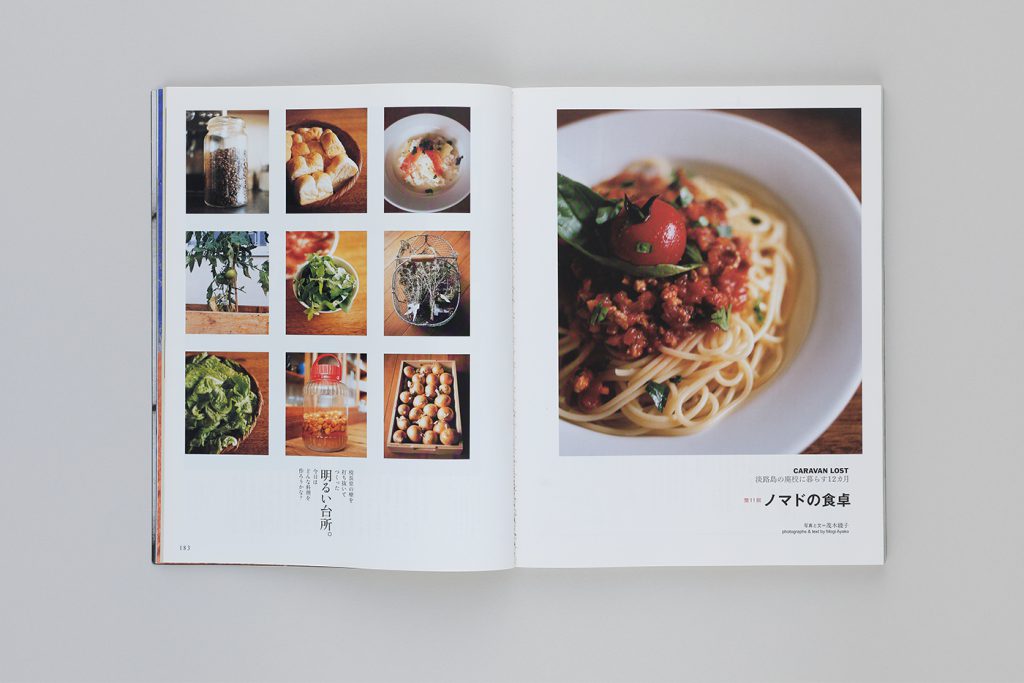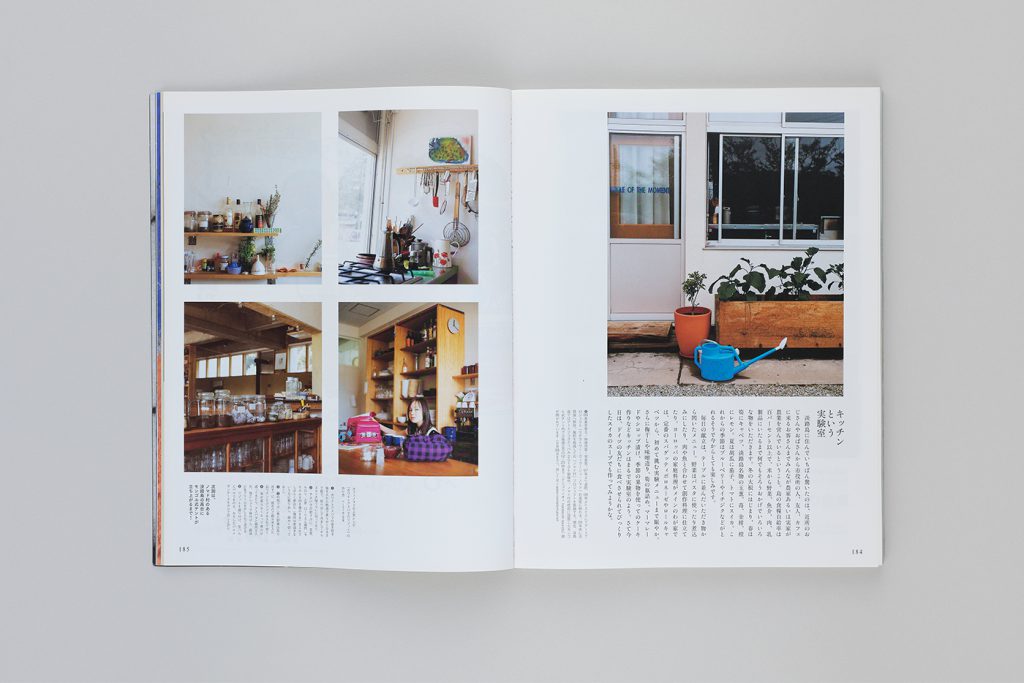

写真と文=茂木綾子
淡路島に住んでいちばん驚いたのは、近所のおじさんやおばさんから市役所の人、友人、カフェに来るお客さんまでみんなが農家あるいは実家が農業を営んでいるということ。島の食料自給率は100パーセント以上で、米から野菜、魚介、肉、乳製品にいたるまで何でもそろうおかげでいろいろな物をいただきます。冬の大根にはじまり、春は筍にキャベツ、淡路島名物の玉葱、苺、金柑、橙にレモン。夏は胡瓜に茄子、トマトにスイカ。これからの季節はブルーベリーやイチジクなどがとれるそうで今からとても楽しみです。
毎日の献立は、テーブルに並んだいただき物から閃いたメニュー。野菜はパスタに使ったり煮込みにしたり、肉や魚と合わせて創作料理に仕立てたり。ヨーロッパの家庭料理がメインのわが家では、定番のスパゲティボロネーゼやロールキャベツから、初めて挑む実験メニューまでにぎやか。さらに梅干しや味噌造り、筍の瓶詰め、マーマレードやシロップ漬け、季節の果物を使ってのケーキづくりなどキッチンはまるで実験室のよう。さて今日は、ドイツの友だちに食べさせられてびっくりしたスイカのスープでもつくってみようかな。
● カフェノマドの人気レシピ
「ホワイトアスパラのリゾット」のつくり方
❶ ホワイトアスパラの皮を剥き、塩を入れた熱湯で柔らかくなるまで茹で、取り出して冷ましてから3センチ幅ぐらいに切っておく。
❷ アスパラの茹で汁に、玉葱、セロリ、人参、ローリエと鶏肉(モモかムネ肉を塊のまま)を入れてしばらく煮込む(鶏肉は煮過ぎないうちに取り出し、細かく切っておく)。
❸ ❷の茹で汁(煮た野菜は取り出す)に、固めのご飯か米を入れ、白ワインとコンソメを入れて炊く。
❹ コメが柔らかくなって煮汁が減ってきたら、アスパラと鶏肉を入れ、塩こしょうで味付けし、最後に生クリームを少し入れて混ぜる。
❺ リゾットを盛り付け、生ハムとパセリをのせ、おろしたパルメザンチーズをかけてできあがり。
—
淡路島に住んでいちばん驚いたのは、近所のおじさんやおばさんから市役所の人、友人、カフェに来るお客さんまでみんなが農家あるいは実家が農業を営んでいるということ。島の食料自給率は100パーセント以上で、米から野菜、魚介、肉、乳製品にいたるまで何でもそろうおかげでいろいろな物をいただきます。冬の大根にはじまり、春は筍にキャベツ、淡路島名物の玉葱、苺、金柑、橙にレモン。夏は胡瓜に茄子、トマトにスイカ。これからの季節はブルーベリーやイチジクなどがとれるそうで今からとても楽しみです。
毎日の献立は、テーブルに並んだいただき物から閃いたメニュー。野菜はパスタに使ったり煮込みにしたり、肉や魚と合わせて創作料理に仕立てたり。ヨーロッパの家庭料理がメインのわが家では、定番のスパゲティボロネーゼやロールキャベツから、初めて挑む実験メニューまでにぎやか。さらに梅干しや味噌造り、筍の瓶詰め、マーマレードやシロップ漬け、季節の果物を使ってのケーキづくりなどキッチンはまるで実験室のよう。さて今日は、ドイツの友だちに食べさせられてびっくりしたスイカのスープでもつくってみようかな。
● カフェノマドの人気レシピ
「ホワイトアスパラのリゾット」のつくり方
❶ ホワイトアスパラの皮を剥き、塩を入れた熱湯で柔らかくなるまで茹で、取り出して冷ましてから3センチ幅ぐらいに切っておく。
❷ アスパラの茹で汁に、玉葱、セロリ、人参、ローリエと鶏肉(モモかムネ肉を塊のまま)を入れてしばらく煮込む(鶏肉は煮過ぎないうちに取り出し、細かく切っておく)。
❸ ❷の茹で汁(煮た野菜は取り出す)に、固めのご飯か米を入れ、白ワインとコンソメを入れて炊く。
❹ コメが柔らかくなって煮汁が減ってきたら、アスパラと鶏肉を入れ、塩こしょうで味付けし、最後に生クリームを少し入れて混ぜる。
❺ リゾットを盛り付け、生ハムとパセリをのせ、おろしたパルメザンチーズをかけてできあがり。
—
photographs & text by Ayako Mogi
The most surprising thing about living on Awaji Island is that everyone from the neighbors to the people at the city office, friends, and customers who come to the cafe are farmers or have family members who are farmers. The island’s food self-sufficiency rate is over 100 percent, and thanks to the availability of everything from rice to vegetables, seafood, meat, and dairy products, we receive a wide variety of food. Starting with daikon (Japanese radish) in winter, we have bamboo shoots, cabbage, Awaji Island’s specialty onions, strawberries, kumquats, oranges, and lemons in spring. In summer, there are cucumbers, eggplants, tomatoes, and watermelons. In the coming season, blueberries and figs will be available, and I’m really looking forward to them.
The daily menu was inspired by the gifts we received at the table. Vegetables are used in pasta, stewed, or combined with meat or fish to make creative dishes. In our house, where European home-style cooking is the main cuisine, we have a variety of dishes, from the standard spaghetti bolognese and cabbage rolls to experimental dishes that are new to us. In addition, the kitchen is like a laboratory where we make ume plums, miso, bamboo shoots in jars, marmalade, syrup, and cakes using seasonal fruits. Today, I think I’ll try making watermelon soup, which my German friend surprised me with.
● Cafe Nomade’s popular recipes
How to make “White Asparagus Risotto
❶ Remove the skin from the white asparagus and boil it in boiling salted water until tender, then remove it from the boiling water, let it cool, and cut it into pieces about 3 cm wide.
❷ Add onions, celery, carrots, bay leaves, and chicken (thighs or meat) to the asparagus cooking water and simmer for a while (remove the chicken before overcooking and cut into small pieces).
❸ Add firm rice or rice to the boiled water from ❷ (remove the cooked vegetables), add white wine and consommé, and cook.
❹ When the rice has softened and the cooking water has reduced, add the asparagus and chicken, season with salt and pepper, and finally stir in a little cream.
❺ Serve the risotto with prosciutto and parsley on top, and top with grated Parmesan cheese.
The most surprising thing about living on Awaji Island is that everyone from the neighbors to the people at the city office, friends, and customers who come to the cafe are farmers or have family members who are farmers. The island’s food self-sufficiency rate is over 100 percent, and thanks to the availability of everything from rice to vegetables, seafood, meat, and dairy products, we receive a wide variety of food. Starting with daikon (Japanese radish) in winter, we have bamboo shoots, cabbage, Awaji Island’s specialty onions, strawberries, kumquats, oranges, and lemons in spring. In summer, there are cucumbers, eggplants, tomatoes, and watermelons. In the coming season, blueberries and figs will be available, and I’m really looking forward to them.
The daily menu was inspired by the gifts we received at the table. Vegetables are used in pasta, stewed, or combined with meat or fish to make creative dishes. In our house, where European home-style cooking is the main cuisine, we have a variety of dishes, from the standard spaghetti bolognese and cabbage rolls to experimental dishes that are new to us. In addition, the kitchen is like a laboratory where we make ume plums, miso, bamboo shoots in jars, marmalade, syrup, and cakes using seasonal fruits. Today, I think I’ll try making watermelon soup, which my German friend surprised me with.
● Cafe Nomade’s popular recipes
How to make “White Asparagus Risotto
❶ Remove the skin from the white asparagus and boil it in boiling salted water until tender, then remove it from the boiling water, let it cool, and cut it into pieces about 3 cm wide.
❷ Add onions, celery, carrots, bay leaves, and chicken (thighs or meat) to the asparagus cooking water and simmer for a while (remove the chicken before overcooking and cut into small pieces).
❸ Add firm rice or rice to the boiled water from ❷ (remove the cooked vegetables), add white wine and consommé, and cook.
❹ When the rice has softened and the cooking water has reduced, add the asparagus and chicken, season with salt and pepper, and finally stir in a little cream.
❺ Serve the risotto with prosciutto and parsley on top, and top with grated Parmesan cheese.